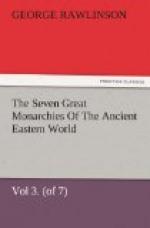The direction of the writing was, as with the Arian nations generally, from left to right. Words were frequently divided, and part carried on to the next line. The characters were inscribed between straight lines drawn from end to end of the tablet on which they were written. Like the Hebrew, they often closely resembled one another, and a slight defect in the stone will cause one to be mistaken for another. The resemblance is not between letters of the same class or kind; on the contrary, it is often between those which are most remote from one another. Thus g nearly resembles u; ch is like d; tr like p; and so on: while k and kh, s and sh, p and ph (or J) are forms quite dissimilar.
It is supposed that a cuneiform alphabet can never have been employed for ordinary writing purposes, but must have been confined to documents of some importance, which it was desirable to preserve, and which were therefore either inscribed on stone, or impressed on moist clay afterwards baked. A cursive character, it is therefore imagined, must always have been in use, parallel with a cuneiform one; and as the Babylonians and Assyrians are known to have used a character of this kind from a very high antiquity, synchronously with their lapidary cuneiform, so it is supposed that the Arian races must have possessed, besides the method which has been described as a cursive system of writing. Of this, however, there is at present no direct evidence. No cursive writing of the Arian nations at this time, either Median or Persian, has been found; and it is therefore uncertain what form of character they employed on common occasions.
The material used for ordinary purposes, according to Nicolas of Damascus and Ctesias, was parchment. On this the kings wrote the despatches which conveyed their orders to the officers who administered the government of provinces; and on this were inscribed the memorials which each monarch was careful to have composed giving an account of the chief events of his reign. The cost of land carriage probably prevented papyrus from superseding this material in Western Asia, as it did in Greece at a tolerably early date. Clay, so much used for writing on both in Babylonia and Assyria, appears never to have approved itself as a convenient substance to the Iranians. For public documents the chisel and the rock, for private the pen and the prepared skin, seem to have been preferred by them; and in the earlier times, at any rate, they employed no other materials.




